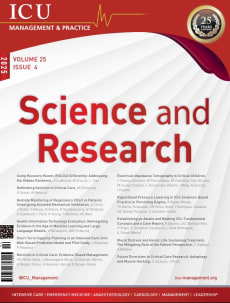Issues
Volume 25 - Issue 4, 2025
Tue, 14 Oct 2025

In this Issue
- Table of contents
- Editorial Board
- Download pdf (print optimised)
- Download pdf (screen optimised)
Editorial
Science and Research
READ MOREThe ICU stands at the forefront of modern medicine, tasked with managing life-threatening conditions in the most vulnerable patients. Treatment success and patient survival depend on robust scientific inquiry and rigorous research. From developing life support technologies to refining clinical protocols, evidence-based practice is the engine that drives safer, more effective care in intensive care....
Cover Story
Using Recovery Rooms (PACUs) Differently: Addressing the Hidden Pandemic
READ MOREThere is increasing interest in extending PACU-based care in order to better address the growing problem of early postoperative complications and their impact on patient and hospital outcomes. There is promising evidence of benefit in this approach, but still a great deal to be learned, such as the optimal target patient population, the precise value generated, and the structures, processes and specific ca...
Biomarkers and Point-of-Care Innovation in the Emergency Department
READ MOREBiomarkers are essential tools in the emergency department for improving early detection, risk stratification, and patient management. This article reviews challenges in biomarker integration, the diagnostic and prognostic value of pancreatic stone protein (PSP), and the role of point-of-care solutions such as the abioSCOPE® in advancing personalised emergency medicine. Emergency departments (ED...
Rethinking Delirium in Critical Care
READ MOREDelirium is a common but under-recognised ICU complication with short and long term cognitive, psychological, and functional consequences. It urges for a cultural change in critical care using routine screening, multidisciplinary prevention, and patient and family centred interventions to prioritise mental recovery alongside physical survival. Mr D, a 70-year-old engineer, was admitted to the ICU wit...
Redefining Rate Control Strategy With Landiolol: Manage the Rhythm Without Compromising the System
READ MORELandiolol, an ultra-short-acting and highly β1-selective intravenous β-blocker, addresses the need for rapid and controllable arrhythmia suppression while maintaining cardiovascular stability. Recently approved in the United States and already in use in Europe, landiolol combines rapid onset and offset with a favourable haemodynamic profile. Tachyarrhythmias frequently complicate the clinical cours...
Bedside Monitoring of Respiratory Effort in Patients Undergoing Assisted Mechanical Ventilation
READ MOREThis review explores bedside methods for monitoring respiratory effort in patients undergoing assisted mechanical ventilation. It highlights the risks of lung and diaphragm injury from excessive or insufficient patient effort, reviews invasive and non-invasive pressure-based techniques, and discusses their strengths, limitations, and proposed safety thresholds. The article emphasises integrating these tool...
Health Information Technology Evaluation: Reimagining Evidence in the Age of Machine Learning & LLMs
READ MOREIn today’s rapidly evolving digital era, health information technologies give enormous opportunity and promise to transform patient care. To unlock their full potential, these innovations must be tested with the same scientific rigour as life-saving drugs and devices. This article invites readers to rethink how we evaluate new technologies in healthcare based on a structured framework to ensure it helps...
Short-Term Capacity Planning in an Intensive Care Unit: Web-Based Prediction Model and Pilot Study
READ MOREICU occupancy varies and cannot be scheduled. To tailor nurse staffing to variable ICU occupancy would potentially decrease both under- and over-staffing. We developed a simple web-based interface for short-term prediction of occupancy and, in a pilot study, compared predicted and observed occupancy. The capacity of intensive care unit (ICU) beds is limited. The main limiting factor for ICU capacit...
Nutrition in Critical Care: Evidence-Based Management
READ MORENutritional support is vital in critical care, yet optimal timing, dose, and composition are debated. Guidelines often conflict with recent trials showing that even lower early goals versus aggressive or early escalating dose may be harmful or not relevant. This review synthesises current evidence, highlighting guideline–trial discrepancies and proposing phase-specific strategies for ICU management....
Electrical Impedance Tomography in Critical Children
READ MOREElectrical impedance tomography (EIT) provides a non-invasive, bedside, radiation-free method for monitoring regional ventilation and pulmonary perfusion in critically ill children. Electrical impedance tomography (EIT) is a non-invasive, radiation-free imaging tool that enables real-time monitoring of regional lung aeration at the patient’s bedside (Bachmann et al. 2018; Costa et al. 2008; Walsh...
Rapid Blood Pressure Lowering in ICH: Evidence-Based Practice or Persisting Dogma
READ MOREThis review examines blood pressure management in intracerebral haemorrhage, highlighting the need to prevent haematoma expansion without causing cerebral hypoperfusion. Guidelines recommend early intervention with systolic targets of 130–150 mmHg, avoiding levels below 130 mmHg. The absence of standardised regimens underscores the need for individualised, evidence-based strategies. Intracerebral...
Establishing an Awake and Walking ICU: Fundamental Concepts and a Case Report
READ MOREImmobilism Syndrome is an often neglected disorder in the critical care setting. The repercussions of this condition are frequently detrimental and enduring, leading to a significant decline in patients' overall ability to operate. Enabling the movement of patients, even when they are undergoing mechanical ventilation and other artificial organ supports, is not only feasible but also advantageous. This art...
Moral Distress and Heroic Life-Sustaining Treatment: The Mitigating Role of the Patient Perspective
READ MOREThis article illustrates two cases of critically ill patients where protracted and burdensome life-saving measures led to discord and moral distress among the ICU team, eventually mitigated by eliciting clear goals and wishes from the patient despite the plan of care and clinical interventions remaining unchanged. The takeaway in these cases is how to understand (and respond to) the multilevel perception o...
Future Directions in Critical Care Research: Autophagy and Muscle Hacking
READ MOREOne of the many facets of critical illness is myopathy, which is associated with increased morbidity and mortality. Here, we delve into the metabolic drivers of muscle wasting, its overlap with frailty syndromes, and how insights into the pathways involved may unveil potential therapeutic strategies. Critical care reflects gruelling illness. Medium to long-term outcomes also reflect a degradation in...
Agenda
Upcoming Events/Courses/Congresses
READ MOREFor a full listing of events visit https://iii.hm/icuevents2025 18–19 SECC Congress 2025 Taipei, Taiwan https://iii.hm/1x5m 21-25 WSES Congress Antalaya, Turkey https://iii.hm/1x5n 25-29 ESICM LIVES 2025 Munich, Germany https://iii.hm/1x5o 31-3 XXII ESRA Eastern European Cadaver Workshop Budapest, Hungary https://iii.hm/1x5p 10-11 International...
























